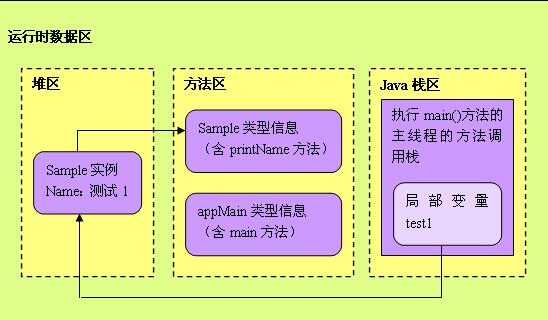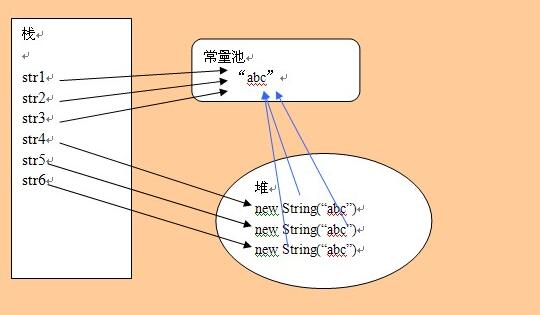1. string 介绍,常用方法源码分析
2. string 常量池分析
常用方法
equals
trim
replace
concat
split
startswith 和 endswith
substring
touppercase() 和 tolowercase()
compareto
string 介绍
string类被final所修饰,也就是说string对象是不可变量,并发程序最喜欢不可变量了。string类实现了serializable, comparable, charsequence接口。
从一段代码说起:
|
1
2
3
4
5
|
public void stringtest(){ string a = "a"+"b"+1; string b = "ab1"; system.out.println(a == b);} |
大家猜一猜结果如何?如果你的结论是true。好吧,再来一段代码:
|
1
2
3
4
5
|
public void stringtest(){ string a = new string("ab1"); string b = "ab1"; system.out.println(a == b);} |
结果如何呢?正确答案是false。
让我们看看经过编译器编译后的代码如何
|
1
2
3
4
5
6
|
//第一段代码public void stringtest() { string a = "ab1"; string b = "ab1"; system.out.println(a == b);} |
|
1
2
3
4
5
6
|
//第二段代码public void stringtest() { string a1 = new string("ab1"); string b = "ab1"; system.out.println(a1 == b);} |
也就是说第一段代码经过了编译期优化,原因是编译器发现"a"+"b"+1和"ab1"的效果是一样的,都是不可变量组成。但是为什么他们的内存地址会相同呢?如果你对此还有兴趣,那就一起看看string类的一些重要源码吧。
源码
一、 string属性
string类中包含一个不可变的char数组用来存放字符串,一个int型的变量hash用来存放计算后的哈希值。
|
1
2
3
4
5
6
|
/** the value is used for character storage. */private final char value[];/** cache the hash code for the string */private int hash; // default to 0/** use serialversionuid from jdk 1.0.2 for interoperability */private static final long serialversionuid = -6849794470754667710l; |
二、 string构造函数
|
1
2
3
4
5
6
7
8
9
10
11
12
13
14
15
16
17
18
19
20
21
22
23
24
25
26
|
//不含参数的构造函数,一般没什么用,因为value是不可变量public string() { this.value = new char[0];}//参数为string类型public string(string original) { this.value = original.value; this.hash = original.hash;}//参数为char数组,使用java.utils包中的arrays类复制public string(char value[]) { this.value = arrays.copyof(value, value.length);}//从bytes数组中的offset位置开始,将长度为length的字节,以charsetname格式编码,拷贝到valuepublic string(byte bytes[], int offset, int length, string charsetname) throws unsupportedencodingexception { if (charsetname == null) throw new nullpointerexception("charsetname"); checkbounds(bytes, offset, length); this.value = stringcoding.decode(charsetname, bytes, offset, length);}//调用public string(byte bytes[], int offset, int length, string charsetname)构造函数public string(byte bytes[], string charsetname) throws unsupportedencodingexception { this(bytes, 0, bytes.length, charsetname);} |
三、 string常用方法
1. equals
|
1
2
3
4
5
6
7
8
9
10
11
12
13
14
15
16
17
18
19
20
21
22
23
24
25
26
27
|
boolean equals(object anobject)public boolean equals(object anobject) { //如果引用的是同一个对象,返回真 if (this == anobject) { return true; } //如果不是string类型的数据,返回假 if (anobject instanceof string) { string anotherstring = (string) anobject; int n = value.length; //如果char数组长度不相等,返回假 if (n == anotherstring.value.length) { char v1[] = value; char v2[] = anotherstring.value; int i = 0; //从后往前单个字符判断,如果有不相等,返回假 while (n-- != 0) { if (v1[i] != v2[i]) return false; i++; } //每个字符都相等,返回真 return true; } } return false;} |
|
1
2
3
|
string e1 = "good";string e2 = "good everyday";e1.equals(e2); // 返回 false |
1 首先判断是否 引用同一个对象 == 也就是判断 这两个引用的 内存地址是否相同,如果相同 直接返回 true
2 会判断是否类型 相同,是否是同一种数据类型
3 类型 相同 就会比较 转换成的 字符 数组的长度 是否相同
4 从后往前 比较 每一个字符 是否 相同
判断顺序 =》 1.内存地址 2.数据类型 3.字符数组长度 4.单个字符比较
2. compareto
|
1
2
3
4
5
6
7
8
9
10
11
12
13
14
15
16
17
18
19
20
21
22
23
|
int compareto(string anotherstring)public int compareto(string anotherstring) { //自身对象字符串长度len1 int len1 = value.length; //被比较对象字符串长度len2 int len2 = anotherstring.value.length; //取两个字符串长度的最小值lim int lim = math.min(len1, len2); char v1[] = value; char v2[] = anotherstring.value; int k = 0; //从value的第一个字符开始到最小长度lim处为止,如果字符不相等,返回自身(对象不相等处字符-被比较对象不相等字符) while (k < lim) { char c1 = v1[k]; char c2 = v2[k]; if (c1 != c2) { return c1 - c2; } k++; } //如果前面都相等,则返回(自身长度-被比较对象长度) return len1 - len2;} |
|
1
2
3
4
5
6
|
string co1 = "hello" ;string co2 = "hello";string co3 = "hello you"; system.out.println(co1.compareto(co2)); // 0system.out.println(co1.compareto(co3)); // -4 |
这个方法写的很巧妙,先从0开始判断字符大小。
如果两个对象能比较字符的地方比较完了还相等,就直接返回自身长度减被比较对象长度,如果两个字符串长度相等,则返回的是0,巧妙地判断了三种情况。
3.hashcode
|
1
2
3
4
5
6
7
8
9
10
11
12
13
14
15
16
|
int hashcode()public int hashcode() { int h = hash; //如果hash没有被计算过,并且字符串不为空,则进行hashcode计算 if (h == 0 && value.length > 0) { char val[] = value; //计算过程 //s[0]*31^(n-1) + s[1]*31^(n-2) + ... + s[n-1] for (int i = 0; i < value.length; i++) { h = 31 * h + val[i]; } //hash赋值 hash = h; } return h;} |
|
1
2
3
4
5
6
7
8
9
10
11
12
|
string a = "toyou";char val[] = a.tochararray();char c1 = 't';char c2 = 'a';int f = c1; int e = c2; system.out.println(e); // 97 asystem.out.println(f); // 116 tsystem.out.println(31*val[0]); // 3596system.out.println(31*c1); // 3596// hashcode 计算中 因为char 字符可以自动转换成对应的 int 整形 |
string类重写了hashcode方法,object中的hashcode方法是一个native调用。
string类的hash采用多项式计算得来,我们完全可以通过不相同的字符串得出同样的hash,所以两个string对象的hashcode相同,并不代表两个string是一样的。
同一个string 对象 hashcode 一定相同, 但是 hashcode相同 ,不一定是同一个对象
4.startswith
|
1
2
3
4
5
6
7
8
9
10
11
12
13
14
15
16
17
18
19
20
21
22
23
24
25
26
|
boolean startswith(string prefix,int toffset)public boolean startswith(string prefix, int toffset) { char ta[] = value; int to = toffset; char pa[] = prefix.value; int po = 0; int pc = prefix.value.length; // note: toffset might be near -1>>>1. //如果起始地址小于0或者(起始地址+所比较对象长度)大于自身对象长度,返回假 if ((toffset < 0) || (toffset > value.length - pc)) { return false; } //从所比较对象的末尾开始比较 while (--pc >= 0) { if (ta[to++] != pa[po++]) { return false; } } return true;}public boolean startswith(string prefix) { return startswith(prefix, 0);}public boolean endswith(string suffix) { return startswith(suffix, value.length - suffix.value.length);} |
|
1
2
3
4
|
string d = "www.58fxp.com"; system.out.println(d.startswith("www")); // true system.out.println(d.endswith("com")); // true |
起始比较和末尾比较都是比较经常用得到的方法,例如在判断一个字符串是不是http协议的,或者初步判断一个文件是不是mp3文件,都可以采用这个方法进行比较。
5.concat
|
1
2
3
4
5
6
7
8
9
10
11
12
|
string concat(string str)public string concat(string str) { int otherlen = str.length(); //如果被添加的字符串为空,返回对象本身 if (otherlen == 0) { return this; } int len = value.length; char buf[] = arrays.copyof(value, len + otherlen); str.getchars(buf, len); return new string(buf, true);} |
|
1
2
3
|
string cat = "much"; string newcat = cat.concat(" yes"); // much yes |
concat方法也是经常用的方法之一,它先判断被添加字符串是否为空来决定要不要创建新的对象。
1 如果 拼接的字符 长度为0 直接返回 原字符对象
2 拼接的字符 不为空 返回 新的 字符对象
判断字符长度 生成新对象
6.replace
|
1
2
3
4
5
6
7
8
9
10
11
12
13
14
15
16
17
18
19
20
21
22
23
24
25
26
27
28
29
|
string replace(char oldchar,char newchar)public string replace(char oldchar, char newchar) { //新旧值先对比 if (oldchar != newchar) { int len = value.length; int i = -1; char[] val = value; /* avoid getfield opcode */ //找到旧值最开始出现的位置 while (++i < len) { if (val[i] == oldchar) { break; } } //从那个位置开始,直到末尾,用新值代替出现的旧值 if (i < len) { char buf[] = new char[len]; for (int j = 0; j < i; j++) { buf[j] = val[j]; } while (i < len) { char c = val[i]; buf[i] = (c == oldchar) ? newchar : c; i++; } return new string(buf, true); } } return this;} |
|
1
2
3
4
|
string r1 = "how do you do"; string r2 = r1.replace("do","is");system.out.println(r2); // how is you is |
这个方法也有讨巧的地方,例如最开始先找出旧值出现的位置,这样节省了一部分对比的时间。
replace(string oldstr,string newstr)方法通过正则表达式来判断。
7.trim
|
1
2
3
4
5
6
7
8
9
10
11
12
13
14
15
16
|
string trim()public string trim() { int len = value.length; int st = 0; char[] val = value; /* avoid getfield opcode */ //找到字符串前段没有空格的位置 while ((st < len) && (val[st] <= ' ')) { st++; } //找到字符串末尾没有空格的位置 while ((st < len) && (val[len - 1] <= ' ')) { len--; } //如果前后都没有出现空格,返回字符串本身 return ((st > 0) || (len < value.length)) ? substring(st, len) : this;} |
|
1
2
3
4
5
6
7
8
9
|
string t1 = " public void "; // 前后各一个空格 system.out.println("t1:"+t1.length()); // 13 带空格长度 string t2 = t1.trim(); system.out.println("t2:"+t2.length()); // 11 去掉空格 system.out.println(t2); |
8.intern
|
1
2
|
string intern()public native string intern(); |
|
1
|
string dd = new string("bb").intern(); |
ntern方法是native调用,它的作用是在方法区中的常量池里通过equals方法寻找等值的对象,
如果没有找到则在常量池中开辟一片空间存放字符串并返回该对应string的引用,否则直接返回常量池中已存在string对象的引用。
可以为new方法创建的 字符对象 也去强制查看常量池 是否已存在
将引言中第二段代码
|
1
2
3
|
//string a = new string("ab1");//改为string a = new string("ab1").intern(); |
则结果为为真,原因在于a所指向的地址来自于常量池,而b所指向的字符串常量默认会调用这个方法,所以a和b都指向了同一个地址空间。
|
1
2
3
4
5
6
7
8
9
10
11
12
13
|
int hash32()private transient int hash32 = 0;int hash32() { int h = hash32; if (0 == h) { // harmless data race on hash32 here. h = sun.misc.hashing.murmur3_32(hashing_seed, value, 0, value.length); // ensure result is not zero to avoid recalcing h = (0 != h) ? h : 1; hash32 = h; } return h;} |
在jdk1.7中,hash相关集合类在string类作key的情况下,不再使用hashcode方式离散数据,而是采用hash32方法。
这个方法默认使用系统当前时间,string类地址,system类地址等作为因子计算得到hash种子,通过hash种子在经过hash得到32位的int型数值。
|
1
2
3
4
5
6
7
8
9
10
11
12
13
14
15
|
public int length() { return value.length;}public string tostring() { return this;}public boolean isempty() { return value.length == 0;}public char charat(int index) { if ((index < 0) || (index >= value.length)) { throw new stringindexoutofboundsexception(index); } return value[index];} |
以上是一些简单的常用方法。
总结
string对象是不可变类型,返回类型为string的string方法每次返回的都是新的string对象,除了某些方法的某些特定条件返回自身。
string对象的三种比较方式:
==内存比较:直接对比两个引用所指向的内存值,精确简洁直接明了。
equals字符串值比较:比较两个引用所指对象字面值是否相等。
hashcode字符串数值化比较:将字符串数值化。两个引用的hashcode相同,不保证内存一定相同,不保证字面值一定相同。
字符串常量池的设计思想
一.字符串常量池设计初衷
每个字符串都是一个string对象,系统开发中将会频繁使用字符串,如果像其他对像那样创建销毁将极大影响程序的性能。
jvm为了提高性能和减少内存开销,在实例化字符串的时候进行了优化
为字符串开辟了一个字符串常量池,类似于缓存区
创建字符串常量时,首先判断字符串常量池是否存在该字符串
存在该字符串返回引用实例,不存在,实例化字符串,放入池中
实现基础
实现该优化的基础是每个字符串常量都是final修饰的常量,不用担心常量池存在数据冲突
运行时实例创建的全局字符串常量池中有一个表,总是为池中每个唯一的字符串对象维护一个引用,这就意味着它们一直引用着字符串常量池中的对象,所以,在常量池中的这些字符串不会被垃圾收集器回收
堆、栈、方法区
了解字符串常量池,首先看一下 堆栈方法区

堆
存储的是对象,每个对象都包含一个与之对应的class
jvm只存在一个堆区,被所有线程共享,堆中不存在基本类型和对象引用,只存在对象本身
对象由垃圾回收器负责回收,因此大小和生命周期不需要确定
栈
每个线程都包含一个栈区,栈区只存放基础数据类型对象和自定义对象引用
每个栈中的数据(原始类型和对象引用)都是私有的
栈分为三个部分,基本类型变量区、执行环境上下文、操作指令区(存放操作指令)
数据大小和生命周期是可以确定的,当没有引用指向这个数据时,这个数据就会消失
方法区
静态区,跟堆一样,被所有的线程共享
方法区包含的都是在整个程序中永远唯一的元素,如class、static变量;
字符串常量池
字符串常量池存在于方法区
代码:堆栈方法区存储字符串
|
1
2
3
4
5
|
string str1 = “abc”;string str2 = “abc”;string str3 = “abc”;string str4 = new string(“abc”);string str5 = new string(“abc”); |

面试题
string str4 = new string(“abc”) 创建多少个对象?
拆分: str4 = 、 new string()、"abc"
通过new 可以创建一个新的对象,new 方法创建实例化对象不会去常量池寻找是否已存在,只要new 都会实例化一个新的对象出来
"abc"每个字符串 都是一个string 对象,如果常量池中没有则会创建一个新对象放入常量池,否则返回对象引用
将对象地址赋值给str4,创建一个引用
所以,常量池中没有“abc”字面量则创建两个对象,否则创建一个对象,以及创建一个引用
string str1 = new string("a"+"b") ; 会创建多少个对象? string str2 = new string("abc") + "abc" ; 会创建多少个对象?
以上这篇java string源码和string常量池的全面解析就是小编分享给大家的全部内容了,希望能给大家一个参考,也希望大家多多支持服务器之家。
原文链接:http://www.cnblogs.com/NiceCui/p/8046564.html















